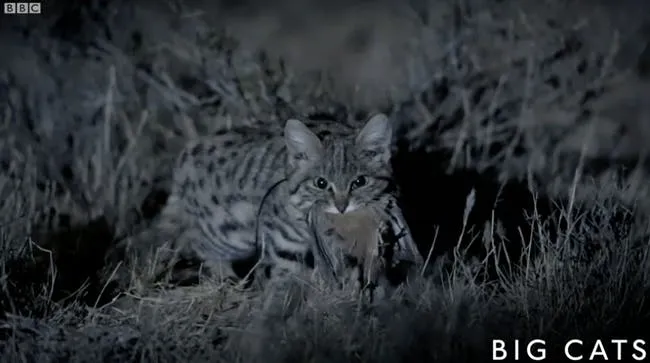This Petite Cat Is the World’s Deadliest. Mini-Series ‘Super Cats’ Shows You Why
The African black-footed cat weighs roughly 200 times less than the average lion, but it has a predation success rate of 60 percent
/https://tf-cmsv2-smithsonianmag-media.s3.amazonaws.com/filer/fd/e7/fde77fde-700d-4a08-8e19-305a0de60130/5879116857_4ab170f4d5_b.jpg)
Standing just 8 to 10 inches tall, the African black-footed cat resembles a petite version of your average neighborhood tabby. But though the speckled feline is unequivocally adorable, a vicious, adept killer lies beneath its charming exterior.
Felis nigripes, as the black-footed feline is formally named, is, in fact, Africa’s smallest cat. To give you some perspective on that statistic, the black-footed cat, which averages 2.4 t0 4.2 pounds, weighs roughly 200 times less than your typical lion. Still, don’t be fooled by its demure stature—the species is also the deadliest of all the world’s felines, capturing more prey in a single night than a leopard does in six months.
As Live Science's Mindy Weisberger reports, the cat's skills were featured in the ongoing PBS Nature miniseries “Super Cats,” which spotlighted the tiny predator in a suitably creepy Halloween installment.
Producer Gavin Boyland tells Weisberger that the filmmakers worked with Cologne Zoo curator Alexander Sliwa to secure footage of the elusive feline. Unlike big cats, the black-footed cat tends to disappear into the tall grasses of the African savannah, making its exploits difficult to track via camera. Luckily, the zoo had previously outfitted several South African-based cats with radio collars, allowing the team to detect their nocturnal hunts with the help of an advanced light-sensitive camera.
The segment itself focuses on a female cat named Gyra. Narrator F. Murray Abraham explains the cat’s excellent night vision and hearing turns “almost anything that moves…[into] a potential meal.”
In the segment, Gyra initially stalks a locust, but she soon abandons it for heartier prey: a short-tailed gerbil. Eyes peeled and back ever-so-slightly arched, she scurries forward and pounces. To her dismay, the gerbil escapes, leaving Gyra to skulk back into look-out position. Soon enough, though, her ears perk and eyes dilate in anticipation as she detects a new meal. Back on the move, she tucks her legs in, getting as low to the ground as possible before suddenly jumping into attack mode. The camera then pulls back to reveal a glimpse of a dying bird, its wings clamped between Gyra’s powerful jaws. She meets the camera’s gaze head-on, unblinking eyes glowing in the darkness.

According to the 2016 IUCN Red List of threatened species, the black-footed cat is “vulnerable,” meaning it is at a high risk of endangerment in the wild. Currently, the species is only found in Botswana, Namibia and South Africa.
Incredibly, previous research has shown that the black-footed cat's predation success rate is 60 percent. Comparatively, lions only succeed in catching their victims about 20 to 25 percent of the time.
Luke Hunter, Chief Conservation Officer at the feline-centered Panthera organization, tells Weisberger that the black-footed cat, which kills an average of 10 to 14 rodents or small birds every night, has an accelerated metabolism that requires it to hunt almost non-stop.
To catch their prey, the creatures draw on a bank of three different techniques: “fast hunting,” or bounding through tall grass and smoking out birds and rodents; “still hunting,” or staking out a rodent’s burrow and pouncing once it appears; and a slowed down version of fast hunting that finds the cats sneaking up on their victims.
“If you're a gazelle or a wildebeest, a black-footed cat isn't at all deadly,” Hunter concludes. “But those success rates make them the deadliest little cat on Earth."
/https://tf-cmsv2-smithsonianmag-media.s3.amazonaws.com/accounts/headshot/mellon.png)
/https://tf-cmsv2-smithsonianmag-media.s3.amazonaws.com/accounts/headshot/mellon.png)